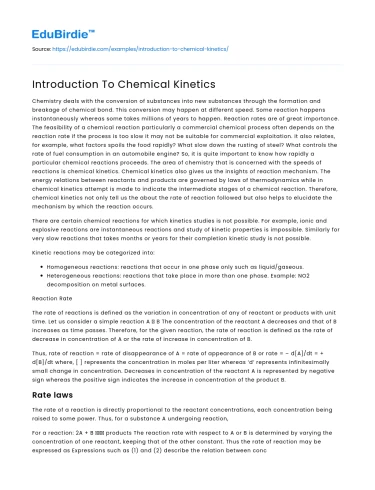Chemistry deals with the conversion of substances into new substances through the formation and breakage of chemical bond. This conversion may happen at different speed. Some reaction happens instantaneously whereas some takes millions of years to happen. Reaction rates are of great importance. The feasibility of a chemical reaction particularly a commercial chemical process often depends on the reaction rate if the process is too slow it may not be suitable for commercial exploitation. It also relates, for example, what factors spoils the food rapidly? What slow down the rusting of steel? What controls the rate of fuel consumption in an automobile engine? So, it is quite important to know how rapidly a particular chemical reactions proceeds. The area of chemistry that is concerned with the speeds of reactions is chemical kinetics. Chemical kinetics also gives us the insights of reaction mechanism. The energy relations between reactants and products are governed by laws of thermodynamics while in chemical kinetics attempt is made to indicate the intermediate stages of a chemical reaction. Therefore, chemical kinetics not only tell us the about the rate of reaction followed but also helps to elucidate the mechanism by which the reaction occurs.
There are certain chemical reactions for which kinetics studies is not possible. For example, ionic and explosive reactions are instantaneous reactions and study of kinetic properties is impossible. Similarly for very slow reactions that takes months or years for their completion kinetic study is not possible.
Save your time!
We can take care of your essay
- Proper editing and formatting
- Free revision, title page, and bibliography
- Flexible prices and money-back guarantee
Kinetic reactions may be categorized into:
- Homogeneous reactions: reactions that occur in one phase only such as liquid/gaseous.
- Heterogeneous reactions: reactions that take place in more than one phase. Example: NO2 decomposition on metal surfaces.
Reaction Rate
The rate of reactions is defined as the variation in concentration of any of reactant or products with unit time. Let us consider a simple reaction A → B The concentration of the reactant A decreases and that of B increases as time passes. Therefore, for the given reaction, the rate of reaction is defined as the rate of decrease in concentration of A or the rate of increase in concentration of B.
Thus, rate of reaction = rate of disappearance of A = rate of appearance of B or rate = – d[A]/dt = + d[B]/dt where, [ ] represents the concentration in moles per liter whereas ‘d’ represents infinitesimally small change in concentration. Decreases in concentration of the reactant A is represented by negative sign whereas the positive sign indicates the increase in concentration of the product B.
Rate laws
The rate of a reaction is directly proportional to the reactant concentrations, each concentration being raised to some power. Thus, for a substance A undergoing reaction,
For a reaction: 2A + B ⎯⎯→ products The reaction rate with respect to A or B is determined by varying the concentration of one reactant, keeping that of the other constant. Thus the rate of reaction may be expressed as Expressions such as (1) and (2) describe the relation between concentrations and the rate of a reaction.
The rate law for a reaction must be determined by experiment. However, for some elementary reactions the powers in the rate law may correspond to coefficients in the chemical equation. But usually the powers of concentration in the rate law are different from coefficients.
Molecularity of a reaction
Chemical reactions may be classed into (a) Elementary reactions and (b) Complex reactions.
An elementary reaction is a simple reaction which occurs in a single step while a complex reaction is that which occurs in two or more steps. Number of reactant molecules involved in an elementary reaction is the molecularity of the reaction. Thus, the molecularity of an elementary reaction is 1, 2, 3, etc., accordingly as one, two or three reactant molecules are participating in the reaction. The elementary reactions having molecularity 1, 2 and 3 are called unimolecular, bimolecular and trimolecular respectively.
It is clear from this relation that half-life for a first order reaction is independent of the initial concentration and it is inversely proportional ot k, the rate-constant.
Similarly, the half-life of the second order reaction is given as . That means that the half-life of a second order reaction depends on initial concentration. This fact can be used to distinguish between a first order and a second order reaction.
Conclusion
Chemical Kinetics deals with the rate of the reactions and the step by step mechanism by which a reaction occurs. It determines the influence of the factors as temperature, pressure, concentration catalyst etc. to the reaction.
References
- K.L. Kapoor, “A Textbook of Physical Chemistry - Vol 2” Macmillan publisher, 2000.
- P. Atkins, “Physical Chemistry”, Oxford University Press, 2002.
- Ira N. Levine, “Physical Chemistry”, McGraw-Hill Higher Education; 6 edition 2008.
- Gilbert William Castellan, “Physical Chemistry”, Addison Wesley; 3rd revised edition 1983.






 Stuck on your essay?
Stuck on your essay?

